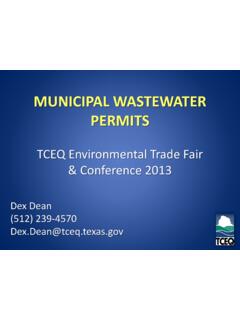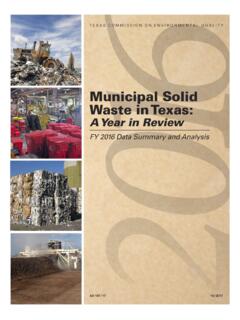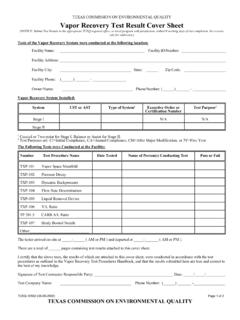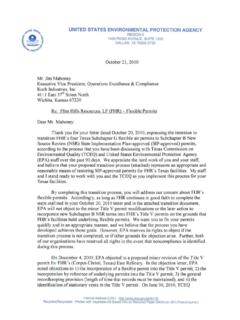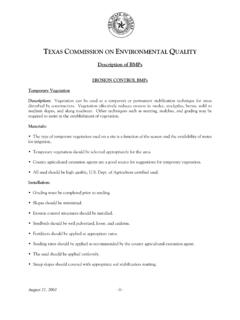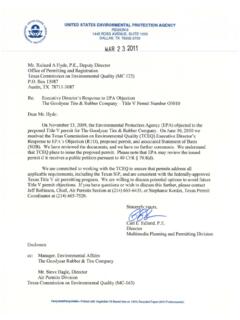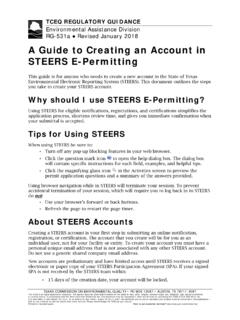Transcription of APPENDIX A—TECHNICAL SUPPLEMENTS - TCEQ
1 tceq publication RG-360A/11 Revised February 2012 A-1 APPENDIX A technical SUPPLEMENTS Disclaimer The Emissions Assessment Section (EAS) has developed technical SUPPLEMENTS for several common emission sources. The SUPPLEMENTS are intended to provide guidance for determining and correctly reporting emissions from specific types of sources, and may not cover every source at the site. It is the responsibility of the owner or operator of a regulated entity to report the emissions from every source required to be included in its EI. See Chapter 1 for information on reporting requirements. These SUPPLEMENTS reflect how certain processes work and how they generate emissions.
2 The SUPPLEMENTS may change over time as a result of findings of scientific studies and as new information becomes available. The EAS greatly appreciates any data, information, or feedback that may improve these SUPPLEMENTS . The methods discussed in this APPENDIX are intended as an aid in calculating emissions. Certain process or operational conditions may make alternate calculation methods equally acceptable if they are based upon, and adequately demonstrate, sound engineering principles or data. It is the responsibility of the owner or operator of a regulated entity to use the best available method to determine and report the emissions that accurately reflect the conditions at his or her site.
3 Additional guidance regarding the acceptability of a given emissions determination method is available from the EAS at 512-239-1773. Miscellaneous VOC Sources One of the goals of the EAS is to identify sources that are failing to report or underreporting their VOC emissions. The sources that fall into this category include, but are not limited to, casing head gas releases, coking units, confined entry ventilation, and Merox units. The EPA has released a draft document titled Emission Estimation Protocol for Petroleum Refineries that is currently under review. Once finalized, this document may provide guidance on determining emissions from coking units and Merox units.
4 The tceq is not aware of any additional specific guidance that is readily available to determine the emissions from these types of sources. If these sources are present at the site, the sources must be represented in the EI and the emissions must be determined and reported in the EI using the best available emission determination methodologies. Casing Head Gas Releases Casing head gas is unprocessed natural gas and other hydrocarbon vapors that emerge at the casing head fitting when crude oil is pumped to the surface of a well. During normal operating conditions, the casing head fitting is tight and no vapors leak into the atmosphere. When the casing Emissions Inventory Guidelines A-2 tceq publication RG-360A/11 Revised February 2012 head gas is vented, any emissions meeting EI reporting requirements must be reported in the EI.
5 Coking Units Coking is a severe method of thermal cracking used to break heavy, long-chained hydrocarbons into lighter products. The residual product of the coking process is a solid carbon substance called petroleum coke. Petroleum coke is removed from the walls of a coke drum by decoking or coke cutting. During the decoking or coke cutting process, VOC gases trapped in the coke will be released while creating hot spots and steam eruptions. Hydrocarbons may also be emitted during the associated cooling and venting of the coke drum prior to decoking. Confined Entry Ventilation Confined entry usually occurs during inspection, repair, or maintenance.
6 Before entry, gas hazards are controlled by purging, inerting, flushing, or ventilating the space as necessary. Examples of confined spaces include, but are not limited to, tanks, manholes, boilers, furnaces, vaults, pipes, trenches, tunnels, ducts, and bins. If the seal of a confined space is broken and uncontrolled, the contaminants within the confined space may be released into the atmosphere. These emissions must be included in the EI. Consult Chapter 3 for information on collective sources to determine if these ventilation emission sources can be grouped in the EI. Merox Units After mercaptan-rich hydrocarbon liquids are treated in a Merox unit, they are often placed in a storage tank.
7 Inert gases may become trapped in this hydrocarbon liquid and can strip VOCs while escaping during storage. The EPA TANKS program may not account for these additional emissions in the calculated emissions report. If the liquid streams are warmer than ambient temperature, see technical supplement 6 for information on hot-product storage to determine the tank s routine emissions. Additional emissions from inert gas stripping must be calculated using sound engineering principles and data. APPENDIX A: Introduction tceq publication RG-360A/11 Revised February 2012 A-3 Glycol Dehydration Operations Glycol dehydration units are used to remove water from natural gas streams to prevent the formation of hydrates and corrosion in the pipeline.
8 Once the glycol is saturated with water, the rich glycol is pumped to a glycol reboiler heater to be regenerated and reused. When the glycol is heated, the VOCs (including BTEX and other HAPs) and water are boiled off and may be released to the atmosphere through the glycol still vent. Whether the GRI-GLYCalc program or a material balance based on a rich-lean analysis is used to determine emissions, an extended gas analysis is necessary for an accurate determination. The wet gas must be sampled at a point in the process ahead of the glycol contactor. The gas analysis must be speciated for each chemical including, but not limited to BTEX and HAPs.
9 For the rich-lean analysis, the rich glycol stream must be sampled at an appropriate location in the process to accurately assess the VOC content ( , after the glycol contactor but before the regenerator or reboiler). The lean glycol stream must be sampled at a point in the process after the regenerator or reboiler. If the process operations include a flash tank, the flash tank emissions must be included in the EI. Controls for the regenerator and flash tank vents can be accounted for in the GRI-GLYCalc program. When the GRI-GLYCalc program is used to determine the emissions, include the Aggregate Summary Emission Report in the sample calculations.
10 Flash tanks must be represented as individual sources in the emissions inventory if they are permitted separately from the glycol still or dehydrator unit. Use the Facility Information VOC Process form to add the glycol flash tank structure to the inventory. For assistance, contact the EAS. Amine Units in Carbon Dioxide Service Amine units in CO2 service that are vented to the atmosphere can be a significant source of VOC emissions (including BTEX and other HAPs). Amine units are used to remove acidic gases including CO2 from natural gas streams. Once the amine is saturated with acid gas, the rich amine is pumped to the amine regenerator to be recycled and the CO2 is often vented to the atmosphere.
